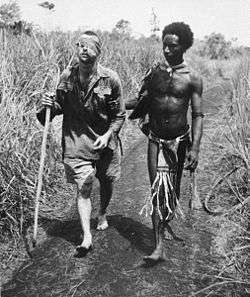Fuzzy Wuzzy Angels

The Fuzzy Wuzzy Angels was the name given by Australian soldiers to a group of Papua New Guinean people who, during World War II, assisted and escorted injured Australian troops down the Kokoda trail. "Fuzzy-Wuzzy" was originally used by British soldiers in the 19th century as a name for Hadendoa warriors on the Red Sea coast of the Sudan, and referred to their elaborate butter-matted hairstyles. The Fuzzy Wuzzy Angels were named for both their frizzy hair and helpful role.
History
In 1942, during the Pacific invasion, the Japanese had built up a force of 13,500 in the Gona region of Papua with the intention of invading Port Moresby. The key to the offensive was an overland trail across the Owen Stanley Ranges. The trail ranged from the small village of Buna on the north coast of Papua and went up the slopes through Gorari and Oivi to Kokoda. The trail was approximately 100 miles (160 km) long, folded into a series of ridges, rising higher and to 7,000 feet (2,100 m) and then declining again to 3,000 feet (910 m). It was covered in thick jungle, short trees and tall trees tangled with vines.
On 29 August 1942, the Japanese task force broke through the Australian line forcing the Australians to retreat further back to Templeton's Crossing. Eventually, the Australians were forced to retreat to Myola.
650 Australian lives were lost in the campaign. It is speculated that this number would have been much larger had it not been for the help of the Fuzzy Wuzzy Angels.[1] As one Australian digger has noted:
- “They carried stretchers over seemingly impassable barriers, with the patient reasonably comfortable. The care they give to the patient is magnificent. If night finds the stretcher still on the track, they will find a level spot and build a shelter over the patient. They will make him as comfortable as possible fetch him water and feed him if food is available, regardless of their own needs. They sleep four each side of the stretcher and if the patient moves or requires any attention during the night, this is given instantly. These were the deeds of the ‘Fuzzy Wuzzy Angels’ – for us!”
No known injured soldier that was still alive was ever abandoned by the Fuzzy Wuzzy Angels, even during heavy combat. In July 2007, grandsons of Australian World War II soldiers and grandsons of the Fuzzy Wuzzy Angels took part in the "Kokoda Challenge".[2]
The last known Fuzzy Wuzzy Angel, Faole Bokoi, died on 7 March 2016.[3]
Official recognition
In June 2008, Australian senator Guy Barnett called for his country's Parliament to give official recognition to Papua New Guineans' courage and contributions to the war effort.
- "I was stunned to learn that Australia has not officially recognised these wonderful PNG nationals who saved the lives of Australian servicemen. They carried stretchers, stores and sometimes wounded diggers directly on their shoulders over some of the toughest terrain in the world. Without them I think the Kokoda campaign would have been far more difficult than it was."[4]
The government agreed to consider the motion. Recognition may entail a medal, a small ex gratia payment, and additional Australian aid to improve people's education and health in villages near the Kokoda trail. [4]
Claims of execution and torture by Australian Army
A video report by the Australian Broadcasting Corporation's Foreign Correspondent TV programme entitled "PNG Digger Hangings" [5] claims execution and torture were used against villagers accused of working with the Japanese Army. The report claims the Army deceived the Australian Government inquiry that followed the executions, grossly understating the number of executions carried out by the Australian Army.
Backed by experts such as Professor Hank Nelson (an eminent historian on the Second World War in PNG), reporter Trevor Bormann stated: "When [Australia's] Federal Cabinet was told of the hangings, it put a stop to them and directed that another fifty Papuans on death row should not face the noose.... Then in their explanation of what happened, field commanders fudged the figures on the number of men who had already been hanged."
According to historian Maclaren Hiari, the victims and families of victims do not want compensation. They only want "acknowledgement or any kind of apology to the people."[6]
References
- ↑ Wendy Lewis, Simon Balderstone and John Bowan (2006). Events That Shaped Australia. New Holland. pp. 169–174. ISBN 978-1-74110-492-9.
- ↑ "Fuzzy wuzzy angel grandsons enlist for Gold Coast hike". ABC News Online. 25 April 2007. Archived from the original on 22 March 2010. Retrieved 11 June 2007.
- ↑ "Last Fuzzy Wuzzy Angel of the Kokoda Track dies". ABC News. Retrieved 2016-03-07.
- 1 2 "Push to honour PNG's fuzzy-wuzzy war angels", Brendan Nicholson, The Age, 26 June 2008
- ↑ http://www.abc.net.au/foreign/content/2007/s2038364.htm PNG - The Digger Hangings of WW2 Broadcast: 25 September 2007 Reporter: Steve Marshall
- ↑ http://www.abc.net.au/foreign/content/2007/s2109947.htm Transcript of "PNG Digger Hangings" Broadcast: 25 September 2007 Reporter: Trevor Bormann
External links
| Wikimedia Commons has media related to Fuzzy Wuzzy Angels. |
- Kokoda: Fuzzy wuzzy angels
- Australian Government History Archives information on the Kokada Trail
- Kokoda Trail Trekking Tours
- "PNG - The Digger Hangings of WW2" synopsis and links
- Transcript of "PNG - Digger Hangings"